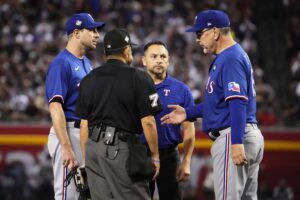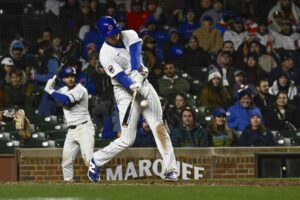In a year where everything is different, one constant from the past few years remained the same – the New York Yankees exiting the postseason far earlier than they expected. For the second year in a row, disappointment overcame the Yankees after a heartbreaking elimination punctuated by Aroldis Chapman allowing a game-losing home run.
Although Chapman has now established a growing trend of postseason failures, pitching, specifically, was not the Yankees main concern. Rather the issue is one that the team dealt with all season long.
The 2020 Yankees were inconsistent, and that was never more evident than in the postseason. Both the offense and the pitching had their fair share of good and bad performances. Consistency, or lack thereof, ultimately cost them the season in the ALDS against the Tampa Bay Rays.
Their regular season breaks into four distinct streaks. They started 16-6, endured a 5-15 stretch, won ten games in a row, and then finished 2-6. That trend continued in the postseason. They won their first three games, but lost three of their last four.
“Every player is probably going to look themselves in the mirror and evaluate themselves and try to find something to work on and get better for next season,” Gerrit Cole said. “We didn’t reach the goal, right? So across the board we need to improve.”
2020 Yankees Pitching Struggles
Even Cole endured a stretch of subpar performances although he was one of the constants for the 2020 Yankees. Still, he acknowledges that overall consistency is an issue for the pitching staff.
During their runs of success in the regular season, the pitching staff allowed 3.9 and 2.5 runs per game*, respectively. In their stretches of futility, they allowed 5.3 and 6.6 runs per game*.
That trend continued in the postseason. While they got three great performances from Cole, with the team allowing seven total runs in those games, they also had three games where they allowed seven, eight, and nine runs. Those games were the result of two uncharacteristic rough outings from Masahiro Tanaka, and the failed-opener experiment.
Tanaka, specifically, was coming off one of his best seasons, posting his second-highest K/BB ratio and third-highest ERA+. In spite of that, his last regular season start and two postseason starts saw 14 earned runs allowed in 12 innings.
“There are times where we pitched really well, there are times where we pitched poorly,” Cole said.
2020 Yankees Hitting Struggles
Even more drastic than the pitching was the fluctuating performances by the offense. When they were 16-6, the offense scored 5.7 runs per game. That number dropped to 3.2 during the 5-15 stretch, and then it rose to 8.5 during the ten-game win steak before dropping to 4.4 during the 2-6 run*. Injuries were a factor, but a lot of regulars still endured hot and cold stretches.
That was also apparent in the postseason. They scored 31 runs in the first three games, a 10.3 average. In the final four, they combined for 15, or 3.8 per game.
“There was a couple of opportunities looking back on the series where we had runners on base, runners in certain situations to either score and kind of keep the inning going and get some of their pitchers to throw some more pitches, and we just weren’t able to capitalize,” Aaron Judge said.
Judge was one of several Yankees hitters that struggled in the ALDS, and he admits he needs to do a better job. He felt the team had good approaches at the plate every game, but they struggled against the Rays’ good pitching.
“I felt like we got to their pitching a little bit, but they were able to make some key pitches in key situations,” Judge said. “They’ve got a great starting rotation, a great bullpen out there, and we just weren’t able to capitalize.”
However, when the Yankees had their offensive outburst in the first three games, they were facing high-quality arms.
Wild Card Series
The Cleveland Indians had the best staff ERA in the AL in 2020. Regardless, the Yankees scored seven runs against Shane Bieber, the likely-Cy Young award winner, in Game One. In Game Two, they staged multiple comebacks against the Indians bullpen.
The Rays had the second-best ERA in the AL, and the Yankees faced Blake Snell, the 2018 AL Cy Young award winner in Game One. They managed four runs off of Snell in five innings, and then they scored another five runs against the Rays’ bullpen that game. Yet, the same team that accomplished that, struck out a record-18 times the very next night.
Specific Performances
Despite the caliber of pitching faced, the Yankees were able to score, but they still lacked the ability to do it consistently. This is apparent when looking at the stark differences between individual regular season and Wild Card Series numbers compared to how they fared throughout the ALDS.
Aside from a towering home run to give the Yankees an early lead in Game Four, Luke Voit was another Yankee that did not come through when it mattered. He hit .111 for the series with two hits, two walks, and six strikeouts. After leading MLB in home runs, he hit .429 with two doubles against the Indians while the lineup was hot, this performance was a significant drop off.
“I feel like I let my team down,” Voit said. “I had a terrible five games against those guys.”
Despite continuing to shine defensively, Wild Card Series Game Two hero Gio Urshela also struggled at the plate. The third baseman totaled six bases and five RBI in two games against the Indians. In five ALDS games, he totaled two bases and zero RBI, slashing .105/.190/.105. This coming after a regular season in which he hit .298 with a 136 OPS+.
In all likelihood, Giancarlo Stanton will be remembered for his offensive success this postseason. His six home runs in the first five postseason games definitely helped the team, but he went 1-7 with a walk and a double in the final two games. It was clear that he was struggling to pick up the spin on the ball in those two games. That appeared evident when he struck out without once swinging the bat while down one run in the ninth inning of Game Five.
Stanton feels the biggest separator was the Rays scoring more runs, and he views the series as a learning experience.
“There was good things learned and some negatives to learn from and go from there,” Stanton said.
Outlook
Not every Yankee saw the drastic fluctuations in performance. Yet, these inconsistencies followed the team all season. As the 2020 Yankees’ season ends and the offseason begins, there is work to be done to improve for 2021.
“Everyone, individually, even myself has a lot of things to work on,” Judge said.
*Stats compiled by the author using data from the New York Yankees statistical department
Main Photo: Embed from Getty Images






